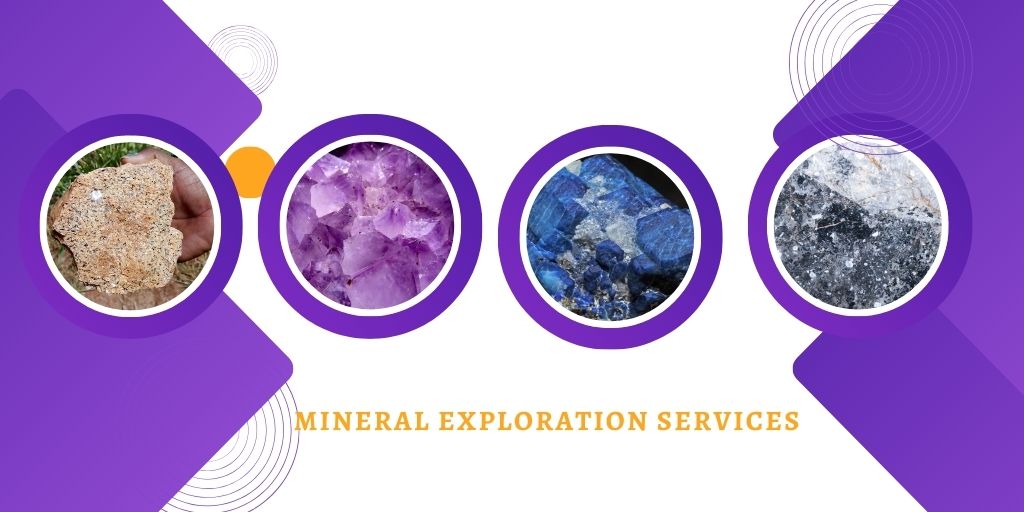
Expert Mineral Exploration Services
Mineral exploration is the process of searching for and discovering valuable mineral deposits beneath the Earth’s surface. It’s a crucial step in the mining industry, providing the raw materials needed for various products and technologies. In this blog post, we’ll explore the intricacies of mineral exploration, from the techniques used to the challenges faced.
About Our Mineral Exploration Services
- Comprehensive Overview: The various aspects of our mineral exploration services, are:
- Geological mapping
- Geophysical surveys
- Remote sensing
- Soil and rock sampling
- Drilling programs
- Value Proposition: Highlight the benefits of your services, such as:
- Accurate mineral deposit identification
- Cost-effective exploration strategies
- Adherence to environmental regulations
- Experienced team of geologists and engineers
Our Approach
- Step-by-Step Process: The typical steps involved in our mineral exploration projects, are:
- Site evaluation and reconnaissance
- Data collection and analysis
- Target identification and prioritization
- Drilling and sampling programs
- Resource estimation and evaluation
- Customized Solutions: Emphasize your ability to tailor your services to meet specific client needs and project requirements.
The Importance of Mineral Exploration
- Economic Growth: Mineral resources play a vital role in driving economic development and creating jobs.
- Technological Advancement: Many modern technologies rely on minerals for their production, from smartphones to electric vehicles.
- Infrastructure Development: Minerals are essential for building infrastructure, such as roads, bridges, and buildings.
Mineral Exploration Techniques
- Geological Mapping: This involves studying the geological features of a region to identify areas with potential mineral deposits.
- Remote Sensing: Using satellites and aerial photography to analyze the Earth’s surface for signs of mineralization.
- Geophysical Surveys: Employing techniques like seismology, magnetometry, and gravity surveys to detect subsurface anomalies.
- Soil and Rock Sampling: Collecting samples from the ground to test for mineral content.
- Drilling: Drilling boreholes to extract samples from deeper depths and assess the extent of a mineral deposit.
Challenges in Mineral Exploration
- Uncertainty: Mineral exploration is inherently risky, as there’s no guarantee of finding a valuable deposit.
- Environmental Impact: Mining operations can have significant environmental consequences, including habitat destruction and pollution.
- Regulatory Hurdles: Obtaining permits and complying with regulations can be time-consuming and costly.
The Future of Mineral Exploration
Advances in technology are revolutionizing the field of mineral exploration. New techniques, such as artificial intelligence and machine learning, are being used to analyze data more efficiently and identify potential targets. Additionally, there is a growing focus on sustainable mining practices that minimize environmental impact.
Types of Mineral Exploration
There are several methods used in mineral exploration, each with its own strengths and limitations. Here’s a breakdown of the most common techniques:
Geophysical Surveys:
- Magnetic Surveys: Detect variations in the Earth’s magnetic field, which can indicate the presence of certain minerals.
- Gravity Surveys: Measure variations in the Earth’s gravity, which can help identify dense mineral deposits.
- Seismic Surveys: Use sound waves to create images of the subsurface, revealing geological structures and potential mineral-bearing zones.
- Electrical Resistivity Surveys: Measure the electrical conductivity of the Earth’s subsurface, which can indicate the presence of minerals with different electrical properties.
Geochemical Surveys:
- Soil Sampling: Analyze soil samples for traces of minerals that may indicate the presence of a mineral deposit.
- Stream Sediment Sampling: Collect and analyze sediment from streams to identify mineral-bearing areas.
- Rock Sampling: Examine rock samples for mineral content and geological structures.
Remote Sensing:
- Satellite Imagery: Use satellite images to identify geological features and potential mineral-bearing areas.
- Aerial Photography: Capture aerial images of the exploration area to assist in mapping and identifying potential targets.
Drilling:
- Diamond Drilling: Extract core samples of rock from the subsurface for detailed analysis.
- Reverse Circulation Drilling: A more cost-effective method for drilling in certain geological conditions.
The Exploration Process
Mineral exploration typically involves a multi-stage process:
- Initial Reconnaissance: Gathering existing geological data and conducting preliminary surveys to identify potential target areas.
- Detailed Exploration: Using a combination of geophysical, geochemical, and remote sensing techniques to refine the target area.
- Drilling: Drilling to obtain core samples for detailed analysis and to assess the size and grade of the mineral deposit.
- Economic Evaluation: Determining the economic feasibility of the mineral deposit, considering factors such as mining costs, market demand, and environmental impact.
Challenges and Innovations
Mineral exploration is a complex and challenging process, with factors such as remote locations, difficult terrain, and the need for specialized equipment and expertise posing significant hurdles. However, advancements in technology, such as drones, artificial intelligence, and data analytics, are revolutionizing the industry, enabling more efficient and effective exploration methods.
Why Choose Us
- Experienced Team
- State-of-the-Art Technology
- Commitment to Quality
- Environmental Responsibility
